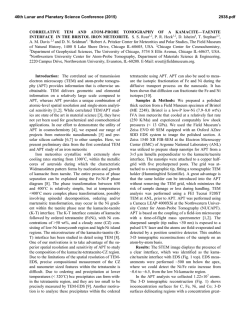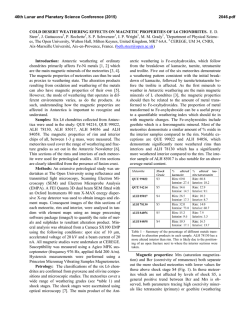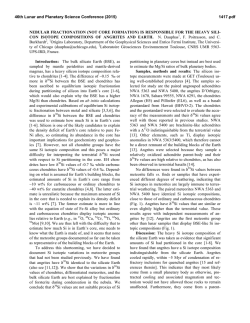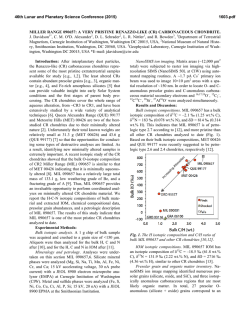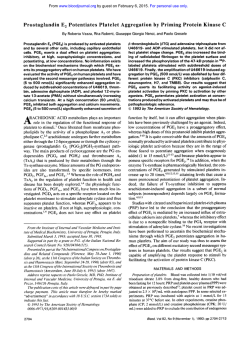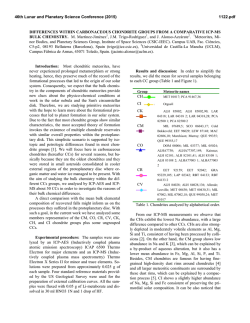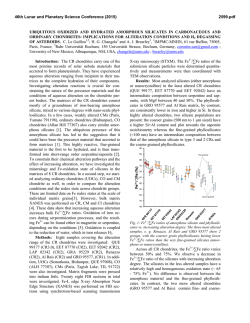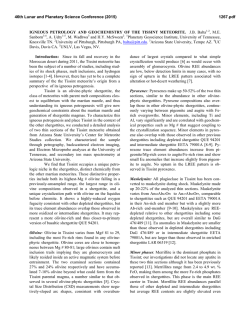
n situ LA-ICP-MS study of platinum group elements and Au in
46th Lunar and Planetary Science Conference (2015) 1791.pdf n situ LA-ICP-MS study of platinum group elements and Au in mesosiderite metallic phase. L. Y. Wang1, W. B. Hsu2, J. W. Li1, 1 Faculty of Earth Resources, China University of Geosciences, Wuhan, 430074, China ([email protected]); 2 Key Laboratory of Planetary Sciences,Purple Mountain Observatory, Chinese Academy of Sciences, Nanjing, 210008, China. Introduction: Mesosiderites are stony-iron meteorites composed of roughly equal proportions of silicates and Fe-Ni metal. Previous analyses show that the bulk composition of metal is close to that of IIIAB irons [1,2], or that of H-group chondrites [3]. Previous analytic techniques (e.g., INAA) determined the abundances of siderophile elements of bulk samples. Little information about the behaviour of the siderophile elements during solid-state segregation of Fe-Ni phases was acquired. In situ LA-ICP-MS analyses can determine the abundances of siderophile elements of spatially resolved kamacite and taenite, and make us acquire the information of the microdistributions and partitioning of siderophile elements within and among the metallic phases of mesosiderites. The information is important for understanding on the genesis and late thermal evolution of metal melts during planetary differentiation [4]. In this study, we focus on analyzing platinum group elements (PGEs: Os, Ir, Ru, Pt, Rh, Pd) and Au in kamacite and taenite of three mesosiderites (Dong Ujimqin Qi, GRV020175 and Vaca Muerta), in order to obtained the information of the PGEs distribution between FeNi-metal phases in mesosiderites. By comparison with Wabar (IIIAB irons), Brenham (Pallasite) and H-group chondrites, we can clarify genetic relationship between the mesosiderite metallic phase with other groups of meteorites. Experimental methods: LA-ICP-MS analyses were performed at the State Key Laboratory of Geological Process and Mineral Resources of China University of Geosciences. Samples were ablated using a Geolas2005 Laserprobe ArF excimer laser ablation system, coupled to an Agilent 7500a ICPMS instrument. Analyses of FeNi-metal (taenite and kamacite) were carried out using a point analysis mode. The spot size was 60µm. We have measured the abundances of Os, Ir, Ru, Pt, Rh, Pd and Au in kamacite and taenite from three mesosiderites Dong Ujimqin Qi (DWQ), GRV020175, and Vaca Muerta (VM). In this study, Fe was used as an internal standard, and Santa Clara (IVB) iron was used as an external standard. Results and Discussion: The PGEs concentrations of kamacite and taenite obtained for DWQ mesosiderites are consistent with the result of previous meteoritic whole rock studies by INAA (Table.1). The close agreement shows that our data is reliable. Both kamacite and taenite of mesosiderites are en- riched in PGEs and Au (~ 10×CI)(Fig.1). PGEs and Au contents of kamacite and taenite are less variable within DWQ and GRV020175 (Fig.1a,b), and more variable within VM (Fig.1c). PGE contents among meteorites exhibit moderate variations that GRV020175 is the most enriched in Pd and Au (Fig.1b). Taenite and kamacite show two distinct patterns. All taenite grains exhibit high abundances of PGE(Total) and are significantly enriched in Ru, Pd and Au. Kamacite is characterized by relatively low PGE(Total) and notably depleted in Ru, Pd and Au (Fig.1a, b, c). Taenite-kamacite partition coefficients (DT/K) are calculated by average PGE compositions of kamacite and taenite and presented in Table 2. DT/K of PGEs and Au in all three mesosiderite shows small variations. Pd and Au have the strongest partitioning (DT/K(Pd) 5-8, DT/K(Au) 4-6.4), Ru shows intermediate partitioning(DT/K(Ru) 1.8-3), and Os, Ir and Pt exhibit the weakest partitioning (DT/K(Os)1-1.3, DT/K(Ir)1-1.4, DT/K(Pt)1.11.6). It indicates that all PGEs elements (especially Pd and Au) partition preferentially into taenite relative to kamacite during slow cooling. The result is consistent with the previous studies [4][7]. The PGE patterns of kamacite and taenite within mesosiderites are different from those of H-group chondrites and Brenham Pallasite (Fig.2). The PGE and Au distributions within mesosiderite FeNi-metal most closely resemble those of Waber IIIAB irons, that they both contain high PGE(Total) and Ru, Pt, Rh contents are consistent with each other. Although there are some minor differences in Os, Ir ,Pd and Au contents(Fig.2). Our analyses confirm a close genetic relationship between mesosiderite metallic phase and IIIAB irons, which are in good accord with those of previous studies using chemical dissolution in conjunction with INAA[1.2]. References: [1] Hassanzadeh J. et al. (1990). GCA, 54: 3197-3208. [2] Wasson J. T. et al. (1974). GCA, 38: 135-149. [3] Xu.L. et al. (2011). AMSM, 74: 5387. [4] Hsu W. et al. (2000). GCA, 64:1133-1147. [5]Kong P. et al. (2008). MAPS, 43:451-460. [6] McDonough and Sun. (1995). Chem. Geol., 120: 223254. [7] Mullane E. et al. (2004). Chem. Geol., 208: 528. [8] Fischer-Goedde M. et al. (2010). GCA, 74: 356-379. [9] Horan M. F. et al. (2003). Chem. Geol., 196: 27-42. 46th Lunar and Planetary Science Conference (2015) Table 1. PGE (ppm) concentrations of kamacite and taenite of DWQ mesosiderite and comparison with previous analytic values. This study [5] Taenite Kamacite Metal Matrix (6) (3) nodule(2) metal Os 6.81±0.34 5.15±0.71 7.62±0.31 5.44 Ir 5.84±0.64 4.70±0.77 6.15±0.09 4.36 Ru 12.21±1.62 4.71±0.62 7.85±0.05 6.2 Pt 10.78±1.08 7.13±0.42 9.07±0.04 8.2 Pd 12.35±1.68 1.69±0.19 4.00±0.10 4 Au 3.49±0.52 0.55±0.05 1.09±0.00 1.16 1791.pdf Table 2. Taenite– kamacite partition coefficients (DT/K) obtained for the DWQ, GRV020175 and VM mesosiderites. DWQ GRV020175 VM DT/K Os 1.32 1.38 1.01 Ir 1.24 1.07 1.06 Ru 2.59 1.85 1.95 Pt 1.51 1.45 1.19 Rh 1.40 1.03 1.17 Pd 7.32 7.48 5.84 Au 6.32 6.22 4.39 Fig.2. Average PGE concentrations for kamacite and taenite in three mesosiderites, Wabar, Brenham and H-group chondrites. Data are normalised to CI-chondrite abundances [6]. Data of Wabar and Brenham from [7], Date of H-group chondrites from [8,9]. Fig. 1. (a) PGE concentrations for kamacite and taenite in DWQ. (b) PGE concentrations for kamacite and taenite in GRV020175.(c) PGE concentrations for kamacite and taenite in VM mesosiderites. Data are normalised to CI-chondrite abundances [6].
© Copyright 2026
